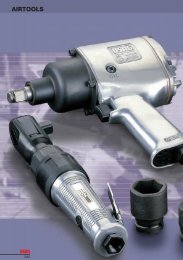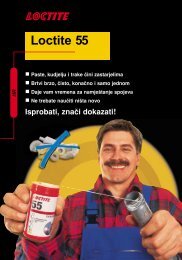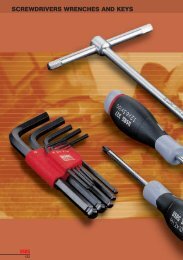Industrial seal self study guide - SKF.com
Industrial seal self study guide - SKF.com
Industrial seal self study guide - SKF.com
You also want an ePaper? Increase the reach of your titles
YUMPU automatically turns print PDFs into web optimized ePapers that Google loves.
Seal Applications (cont.)<br />
An effective solution to separating<br />
two liquids is to install two <strong>seal</strong>s of<br />
same design back to back (fig. 4e).<br />
Sometimes <strong>seal</strong>s are used in<br />
<strong>com</strong>bination to satisfy application<br />
requirements. Here, a V-ring<br />
performs an exclusion function<br />
(fig. 4f).<br />
A variety of factors are used to<br />
determine selection of proper <strong>seal</strong><br />
material (fig. 4g).<br />
An alternative, more effective solution is to use two <strong>seal</strong>s of the same<br />
design (CRW1 or CRWH1) installed back-to-back. The <strong>seal</strong>ing lips must<br />
be pointed toward the liquid which they are intended to retain. One lip<br />
should face the lube, while the other faces the fluid (fig. 4e).<br />
To retain a fluid, a spring-loaded <strong>seal</strong> should be used. If one side will<br />
be occasionally called upon to run in a dry atmosphere, a <strong>com</strong>patible<br />
grease pack should be used in the cavity between the two <strong>seal</strong>s to<br />
insure sufficient lubrication at all times.<br />
Seals Used in Combination<br />
To satisfy the needs of particularly difficult applications (such as<br />
multiple requirements in one location) or extreme operating conditions,<br />
<strong>seal</strong>s can be used in <strong>com</strong>bination. Such applications might be rolling<br />
mills and power take-off assemblies, where lube retention and<br />
contaminant exclusion are equally critical.<br />
There are several <strong>com</strong>binations to choose from, depending on specific<br />
application needs. One solution would be to <strong>com</strong>bine opposed CRW or<br />
HDS <strong>seal</strong>s to retain lube and exclude fine contaminants. Another might<br />
be to use a V-Ring to exclude contaminants and protect radial lip <strong>seal</strong>s<br />
for longer life (fig. 4f).<br />
HDS <strong>seal</strong>s used with V-Rings are usually the correct solution<br />
for applications such as roll necks in milling operations.<br />
Factors Determining Seal Material Selection<br />
Choosing the correct <strong>seal</strong> for an application requires satisfying a<br />
number of operating conditions (fig. 4g). Among these are the<br />
application’s temperature range, lubricant <strong>com</strong>patibility, chemical<br />
<strong>com</strong>patibility, shaft speed(s), shaft surface finish, pressure (internal<br />
or external), contaminants to be excluded, housing material/condition,<br />
and abrasion.<br />
Other factors which should be considered are run-out, shaft-to-bore<br />
misalignment, installation/handling, operating torque and, of course,<br />
cost.<br />
Sealing Element (Lip) Materials<br />
Seals are available with a wide variety of <strong>seal</strong>ing element materials.<br />
Selection should be based on <strong>seal</strong>ing application, <strong>com</strong>patibility with<br />
lubricants and fluids being retained, operation temperatures and<br />
other operating conditions.<br />
Detailed ratings and re<strong>com</strong>mendations for each material can be<br />
found in the first few pages of the <strong>SKF</strong> Handbook of Seals.<br />
34







